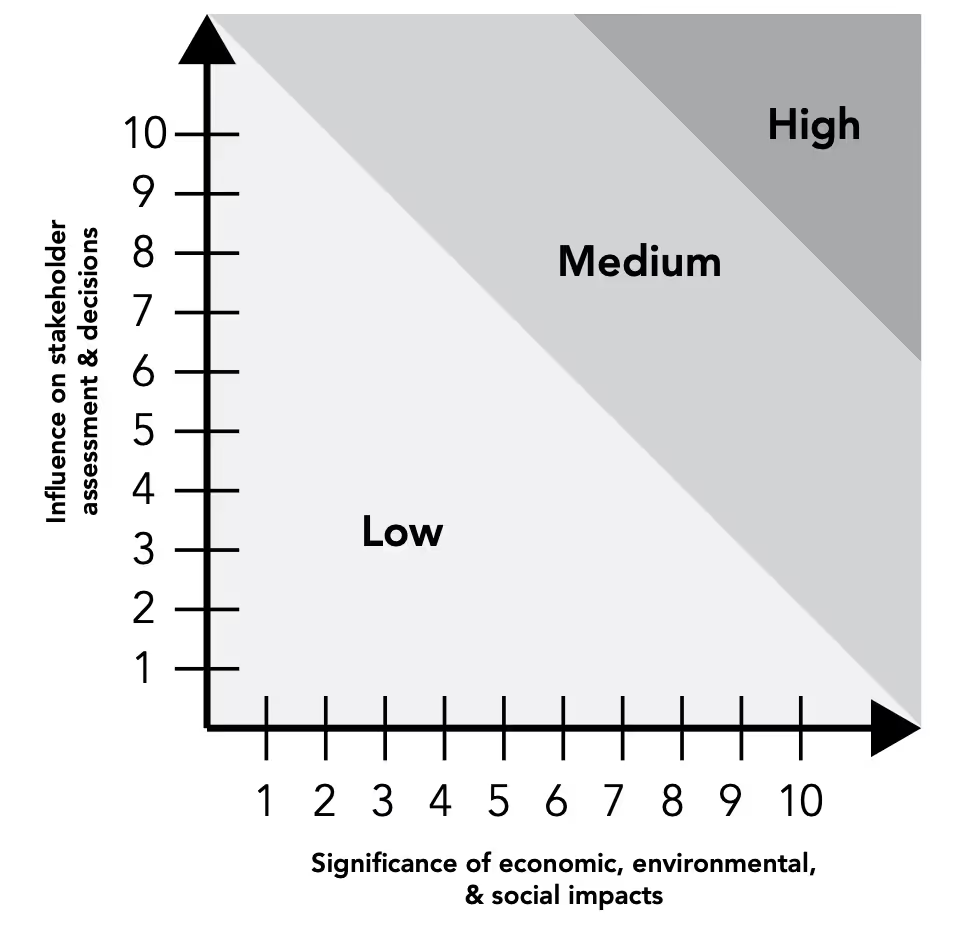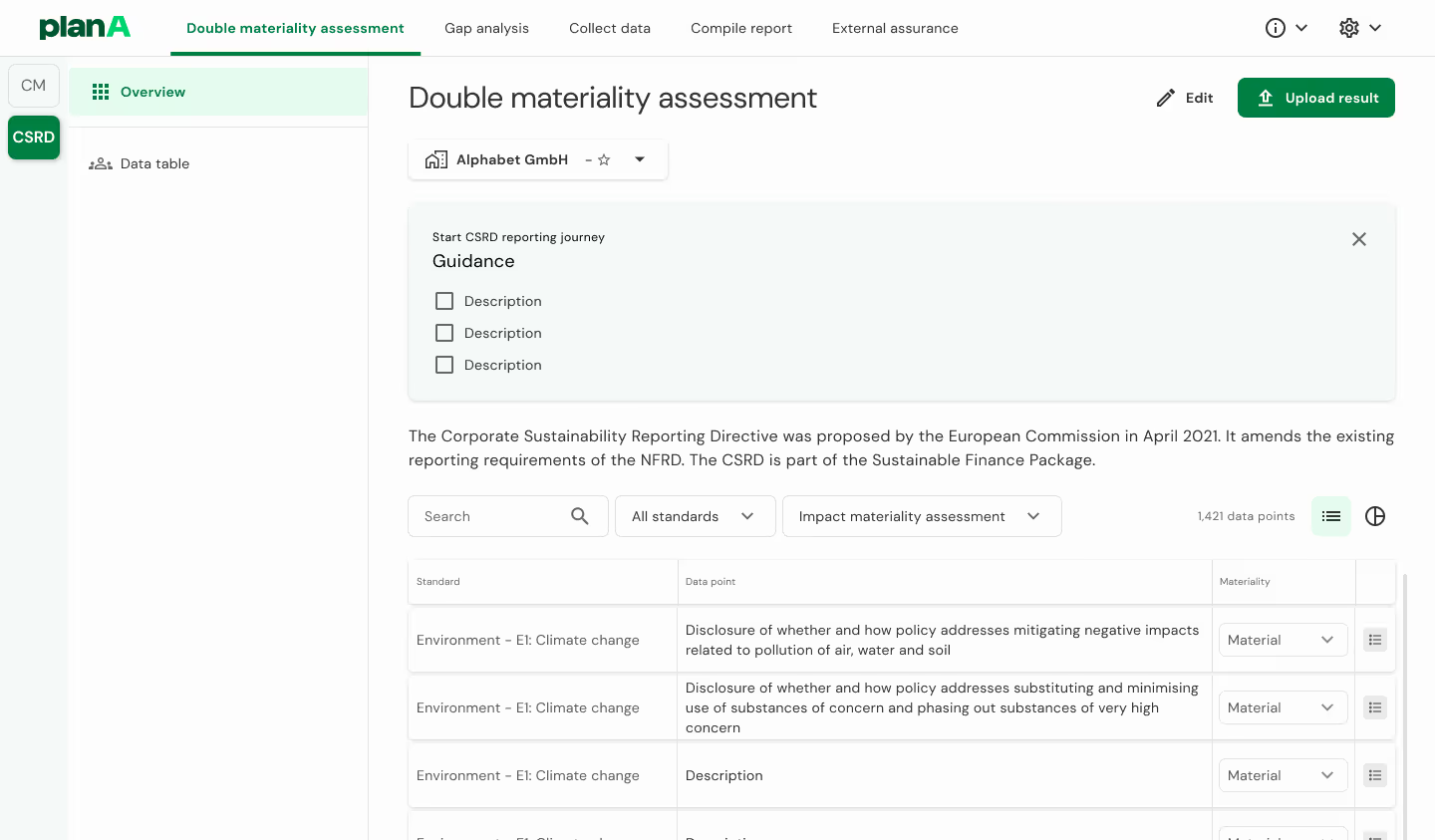In den letzten Jahren sind ESG (Umwelt, Soziales und Unternehmensführung)-Überlegungen in der Unternehmenswelt zunehmend bedeutender geworden. Bis 2025 wird erwartet, dass ESG-relevante Anlagen nahezu die Hälfte aller professionell verwalteten Investitionen ausmachen, was circa 35 Billionen US-Dollar entspricht. Darüber hinaus sprechen sich 87% der CEOs jetzt dafür aus, ESG-Kennzahlen in die reguläre Unternehmensberichterstattung zu integrieren, was den Wandel zu nachhaltigen Geschäftspraktiken unterstreicht.
Unternehmen können verschiedene Nachhaltigkeitsbewertungen durchführen, um ihre ökologischen und sozialen Auswirkungen zu bewerten: Ein entscheidender Test ist die Wesentlichkeitsanalyse, ein zentraler Bestandteil der ESG-Operationen. Wesentlichkeitsbewertungen, die durch Wesentlichkeitsmatrizen visualisiert werden, helfen Organisationen, die bedeutendsten Umwelt-, Sozial- und Governance-Themen zu identifizieren und zu priorisieren, auf die die Organisation Einfluss hat und von denen sie beeinflusst werden könnte, sowie deren potenzielle Chancen. Dieser Artikel untersucht die Bedeutung von Wesentlichkeitsbewertungen und -matrizen, deren Umsetzung und wie sie zur Erreichung von Nachhaltigkeitszielen beitragen.
Was ist eine Wesentlichkeitsanalyse?
Im Einklang mit den GRI (Global Reporting Initiative)-Standards und -Empfehlungen müssen Nachhaltigkeitsberichte die wesentlichen wirtschaftlichen, ökologischen und sozialen Auswirkungen des Unternehmens bewerten und widerspiegeln, um die Nachhaltigkeitsstrategie mit den Erwartungen der Stakeholder in Einklang zu bringen und die Entscheidungsfindung zu informieren.
Eine Nachhaltigkeitsbewertung ist ein strategisches Nachhaltigkeitsinstrument, das verwendet wird, um die ESG-Themen oder -Chancen, die für ein Unternehmen relevant sind, zu verstehen und zu priorisieren, indem interne und externe Interessengruppen einbezogen werden. Dieser Prozess wird häufig durch eine Wesentlichkeitsmatrix visualisiert. Jedes Problem oder jede Chance wird aus der Perspektive des Unternehmens und der Stakeholder bewertet. Schlüsselfragen aus beiden Perspektiven werden dann in die Berichte zur gesellschaftlichen Verantwortung von Unternehmen (CSR) aufgenommen.
Unterschied zwischen Wesentlichkeitsmatrix und Wesentlichkeitsanalyse
Die Wesentlichkeitsmatrix hilft, den ESG-Ansatz zu strukturieren, das Reporting zu vereinfachen und die Glaubwürdigkeit des Unternehmens in den Augen der Investoren zu stärken. Sie zeigt, dass die Organisationen eine Analyse und Bewertung wesentlicher ESG-Themen durchgeführt haben, was Investoren in Anbetracht der finanziellen Risiken im Zusammenhang mit ESG beruhigt. Die Matrix selbst ist eine visuelle Darstellung der Ergebnisse der Wesentlichkeitsanalyse und somit eine Möglichkeit, darzulegen, wie Themen eingestuft werden, um sowohl die Nachhaltigkeitsstrategie als auch das Reporting zu rechtfertigen.
Daher sind Wesentlichkeitsmatrizen und -analysen getrennte, aber sich ergänzende Komponenten der ESG-Aktivitäten:
- Wesentlichkeitsanalysen sind umfassende Prozesse, die ESG-Themen identifizieren und priorisieren.
- Materialitätsmatrizen hingegen sind die visuelle Darstellung der Ergebnisse aus der Bewertung, die die Bedeutung dieser Themen für die Stakeholder und das Unternehmen abbilden.
Bedeutung von Wesentlichkeitsanalysen und -matrizen
Eine Studie von Geldres-Weiss et al. (2021) zeigt, dass Wesentlichkeitsbewertungen und -matrizen dazu beitragen, traditionelle Geschäftsmodelle in nachhaltige umzuwandeln und Innovationen zu integrieren, insbesondere durch verbesserte Entscheidungen und Berichterstattung.
Strategische Planung und Entscheidungsfindung
Wesentlichkeitsmatrizen sind wesentliche Instrumente in der strategischen Planung und Entscheidungsfindung. Durch die Identifizierung und Priorisierung der signifikanten ESG-Herausforderungen ermöglichen diese Werkzeuge Unternehmen, den Erwartungen der Stakeholder und den gesetzlichen Anforderungen gerecht zu werden.
Dies hilft sicherzustellen, dass die Anstrengungen des Unternehmens auf Bereiche mit der größten Wirkung fokussiert sind. Eine Fallstudie von Unilever zeigt die Vorteile der Verwendung einer Wesentlichkeitsmatrix: Das Unternehmen hat zentrale ESG-Themen in sein Geschäftsmodell und seine Strategie integriert, was als Best Practice gilt. Unilever hat spezifische KPIs zu kritischen Themen festgelegt, die im Rahmen seiner Geschäftsergebnisse bewertet werden. Erwähnenswert ist, dass der Bonus des CEO an das Erreichen bestimmter ESG-Ziele geknüpft ist, wie zum Beispiel der Reduzierung von CO₂-Emissionen und der Verbesserung von Gesundheit und Wohlbefinden.
Durch die Verankerung von ESG-Aspekten in seinen Kernoperationen hat Unilever eine verbesserte Markenreputation, verbesserte Stakeholder-Beziehungen und eine langfristige finanzielle Leistung erfahren. Dieser Ansatz der Wesentlichkeitsanalyse hat es Unilever ermöglicht, ESG-Themen effektiv anzugehen und gleichzeitig Innovation und Wachstum voranzutreiben.
Regulatorische Compliance und Reporting
Die Wesentlichkeitsmatrizen tragen auch dazu bei, die Transparenz im Reporting zu verbessern und regulatorische Anforderungen zu erfüllen, insbesondere mit Rahmenwerken wie den GRI, der Richtlinie über die Unternehmensberichterstattung zur Nachhaltigkeit (CSRD) und dem Sustainability Accounting Standards Board (SASB). In der Tat ermöglicht eine gut strukturierte Matrix Unternehmen, sich auf relevante und konforme Informationen mit diesen Standards zu konzentrieren und diese offenzulegen. Dies stärkt die Glaubwürdigkeit ihrer Berichte und schafft Vertrauen bei den Stakeholdern, indem es ein Engagement für Transparenz und Rechenschaftspflicht demonstriert.
Darüber hinaus ist es entscheidend, den Prozess der Wesentlichkeitsanalyse offen zu legen und transparent darzustellen, wie die Ergebnisse ermittelt wurden. Diese Transparenz im Prozess ist ebenso wichtig wie die Analyse selbst, da sie den Interessenvertretern ein klares Verständnis für die Entscheidungsfindung und die Priorisierung von ESG-Themen im Unternehmen vermittelt.
Kritische Komponenten einer Wesentlichkeitsmatrix
Stakeholder-Einbindung
Die Einbindung relevanter Interessengruppen in die Wesentlichkeitsanalyse ist entscheidend, um sicherzustellen, dass die identifizierten ESG-Themen die Perspektiven und Prioritäten derjenigen widerspiegeln, die von der Unternehmensführung betroffen sind oder Einfluss darauf haben. Eine effektive Einbindung der Stakeholder beinhaltet die Konsultation einer vielfältigen Gruppe, darunter Mitarbeiter, Kunden, Investoren, Lieferanten, Mitglieder der Gemeinschaft und ESG-Experten. Dieser Prozess hilft dabei, wertvolle Einblicke zu gewinnen und Vertrauen aufzubauen.
Problemidentifizierung
Um relevante ESG-Themen für die Wesentlichkeitsmatrix zu identifizieren, sollten Unternehmen einen systematischen Prozess wie folgt implementieren:
- Beginnen Sie mit der Überprüfung interner und externer Dokumente: Untersuchen Sie frühere Wesentlichkeitsmatrizen, interne Berichte und Richtlinien sowie externe Rahmenwerke wie GRI und SASB und Berichte von Wettbewerbsunternehmen.
- Branchetrends analysieren: Verwenden Sie Branchenberichte und Marktforschung, um Branchenentwicklungen, regulatorische Änderungen und technologische Fortschritte zu überwachen.
- Denken Sie daran, Stakeholder-Feedback zu berücksichtigen: Sie können dies durch Umfragen, Interviews und Konsultationen tun, um Perspektiven zu sammeln und sicherzustellen, dass die Wesentlichkeitsmatrix die Prioritäten der Stakeholder widerspiegelt.
Zusätzlich könnten gängige ESG-Themen, die im Auge behalten und angegangen werden sollten, Folgendes umfassen:
- Klimawandel und CO₂-Emissionen
- Ressourcenmanagement
- Arbeitspraktiken und Menschenrechte
- Gemeinschaftsengagement
- Unternehmensführung
Priorisierungskriterien
Die Kriterien zur Priorisierung von ESG-Themen beinhalten die Bewertung ihrer Bedeutung für das Unternehmen und die Stakeholder. Wichtige Faktoren sind:
- Finanzieller Einfluss
- Regulatorische Auswirkungen
- Interessen und Bedenken der Interessengruppen
- Langfristige Nachhaltigkeitsziele
Ein Unternehmen könnte zum Beispiel die Reduktion von CO₂-Emissionen priorisieren, aufgrund ihres Beitrags zum Klimawandel, hoher Stakeholder-Bedenken und regulatorischen Drucks.
Visualisierungsmethoden
Eine gute Visualisierung der Wesentlichkeitsmatrix ist entscheidend für Klarheit und Kommunikation. So geht's mit Diagrammen und visuellen Beispielen:
- Verwenden Sie Heatmaps, um die Bedeutung verschiedener Themen zu veranschaulichen.
- Streudiagramme zeigen die Beziehung zwischen Geschäftseinfluss und Anliegen der Stakeholder.
- Blasendiagramme können das Ausmaß der verschiedenen Probleme darstellen.
Schritte zur Entwicklung einer Wesentlichkeitsmatrix
Identifizieren und einbinden von Stakeholdern.
Um eine Wesentlichkeitsmatrix zu entwickeln, beginnen Sie damit, die Stakeholder umfassend zu identifizieren und einzubeziehen. Dies umfasst die Hauptinteressengruppen zu erkennen und Best Practices aus der akademischen Literatur zur Einbindung von Stakeholdern zu implementieren, um eine ausgewogene Darstellung der Perspektiven und Erwartungen sicherzustellen.
Wesentliche Interessengruppen sind externe und interne Akteure, wie Mitarbeiter und Angestellte, der Vorstand, die obere Führungsebene (intern), Kunden, Investoren, NGOs, Mitglieder der lokalen Gemeinschaft, Fakultätsangehörige und Studenten (extern).
Wertschöpfungskette abbilden
Ein entscheidender erster Schritt ist die Abbildung der Wertschöpfungskette, die die Reihe von Schritten umfasst, die ein Unternehmen unternimmt, um Rohstoffe in das Endprodukt umzuwandeln, das den Kunden geliefert wird, einschließlich Produktion, Vertrieb und Entsorgung. Dieser Prozess stellt sicher, dass die gesamten Auswirkungen der Betriebsabläufe sowie alle mit dem Geschäft verbundenen Nachhaltigkeitsrisiken und -chancen berücksichtigt werden.
Identifizieren und priorisieren Sie potenzielle ESG-Themen
Um ESG-Themen zu identifizieren, sollten Unternehmen präzise Risikoanalysen durchführen, branchenspezifische Nachhaltigkeitsberichte überprüfen und Berichtsrahmen konsultieren, um aktuelle oder zukünftige zentrale Herausforderungen zu ermitteln. Diese Themen sollten in der Reihenfolge ihrer Wichtigkeit eingestuft werden, indem das Feedback der Stakeholder integriert und deren Einfluss auf die Unternehmensleistung bewertet wird.
Die Matrix entwickeln
Es gibt drei Hauptmethoden zur Entwicklung einer Wesentlichkeitsmatrix.
Die traditionelle Matrix: Diese Methode besteht darin, eine Zwei-Achsen-Matrix (siehe unten) zu erstellen, um Themen basierend auf ihrem Einfluss auf das Geschäft (X-Achse), bewertet von internen Interessengruppen, und ihrer Bedeutung für externe Interessengruppen (Y-Achse).
Jedes Thema, wie Energieverbrauch, Abfallmanagement, Luftemissionen und Wasserverbrauch, wird anhand von Durchschnittsbewertungen beider Stakeholdergruppen bewertet. Dies kann einfach mit einer 3-Spalten-Tabelle wie folgt erfolgen:

Der Prozess umfasst die Darstellung dieser Bewertungen in der Matrix sowie die Festlegung eines Schwellenwerts, um Themen mit hoher Priorität zu definieren und Klarheit bei der Identifizierung der wichtigen Schwerpunktbereiche für die Nachhaltigkeitsstrategie der Organisation zu gewährleisten.

Aktualisierte Wesentlichkeitsmatrix: Diese Methode behält die Struktur mit zwei Achsen bei, ersetzt jedoch die X-Achse durch die identifizierten, am stärksten wirkenden Umwelt-, Sozial- und Wirtschaftsthemen. Interne und Stakeholder-Antworten werden aggregiert und auf der Y-Achse dargestellt. Ähnlich wie bei Methode 1 kann ein 3-Spalten-Diagramm wie folgt erstellt werden:

Hier ist, wie die Matrix aussehen sollte:

Rankingstabelle: Dieses Verfahren priorisiert Themen, indem sie nach ihrer Relevanzbewertung aufgelistet werden. Die Bewertungen aller Kriterien, einschließlich der Ausschussbewertungen und des Feedbacks von Interessengruppen, bestimmen die Rangfolge jedes Themas. Ein definierter Schwellenwert wird dann angewendet, um die wichtigsten Themen zu identifizieren und zu priorisieren, wodurch eine strategische Ausrichtung auf die Nachhaltigkeitsziele der Organisation sichergestellt wird. Hier ein Beispiel:

Überprüfen und regelmäßig aktualisieren
Es ist entscheidend, die Wesentlichkeitsmatrix regelmäßig zu überprüfen und zu aktualisieren, um Veränderungen in der externen Umgebung und den Erwartungen der Partner widerzuspiegeln. Wesentlichkeitsanalysen sind dynamische Elemente, und Stakeholder sowie Unternehmensprioritäten können sich in sich entwickelnden Kontexten (z. B. während Pandemien, Skandalen usw.) schnell ändern. Diese Praxis stellt sicher, dass das Unternehmen proaktiv mit ESG-Themen umgeht und im Einklang mit den langfristigen Zielen steht.
Zusammenfassend lässt sich sagen, dass die Wesentlichkeitsmatrix entscheidend für Unternehmen ist, die ihre ESG-Leistungen verbessern möchten. Unternehmen können ihre Nachhaltigkeitsbemühungen mit den Erwartungen der Stakeholder und den Anforderungen der Regulierungsbehörden in Einklang bringen, indem sie kritische umwelt-, sozial- und governancebezogene Themen identifizieren und priorisieren. Regelmäßige Aktualisierungen der Matrix gewährleisten die fortlaufende Relevanz und Effektivität der Nachhaltigkeitsstrategie. Die Entwicklung Ihrer Wesentlichkeitsmatrix wird Ihnen helfen, Transparenz, Verantwortung und langfristige Wertschöpfung zu erhöhen.

Vereinbaren Sie einen Anruf, um zu erfahren, wie die CO₂-Management-Plattform von Plan A den Wesentlichkeitsbewertungsprozess optimieren kann, um die Übereinstimmung mit kommenden Vorschriften wie der CSRD sicherzustellen.



.jpg)




